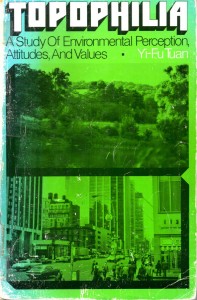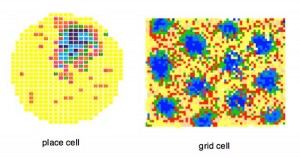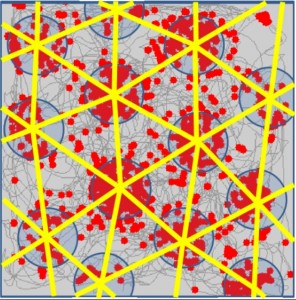The Various Inventions of Topophilia
The word topophilia, which literally means love of place, was popularized by Yi-fu Tuan, a human geographer in his book Topophilia: A Study of Environmental Perception, Attitudes and Values, published in 1974. He apparently thought he had coined the word because he refers to it as a neologism that includes all of “the human being’s affective ties with the material environment” (p.93). I’ll discuss that book in a moment, but there were a couple of prior and significant, albeit brief, uses of the word.
The first use seems to have been by the poet W.H. Auden when he wrote in 1947 in his introduction for Slick but not Streamlined, a book by the English poet John Betjeman, that he hoped it “will inspire American topophils to take poetry seriously and American poets to take topophilia seriously.” The places Betjeman loved and wrote poems about were mostly the interwar suburbs of England.
So tophophils are lovers of place, and I suppose I must also be sort of intellectual “topophil” because I have devoted so much energy to writing about place.
A few years later Gaston Bachelard, the French phenomenologist, gave topophilia a slightly different and methodological meaning in The Poetics of Space. He used it to refer to his investigations of poetic images of “felicitous space” that “seek to determine the human value of the sorts of space that may be grasped, that may be defended against adverse forces, the space that we love” (p.xxxi). It is unclear whether Bachelard had borrowed the word from Auden or coined it for himself. Whatever is the case, the word appears to be an invention of the late-twentieth century, though the sentiments it encompasses are presumably as old as humanity.
Tuan’s Topophilia
For Tuan, who refers neither to Auden nor Bachelard, topophilia is “the affective bond between people and place or setting” (p.4). It is, he wrote, “not the strongest of human emotions” (p.93). And it varies greatly in emotional range and intensity, including fleeting visual pleasure, the sensual delight of physical contact, the fondness for familiar places such as home, and joy because of health and vitality (p.247). But for all that, it strikes a chord. It is a familiar sentiment, a word that encapsulates the pleasantly varied relationships we have with particular bits of the world both as individuals and as participants in cultures with long histories.
Tuan’s book is more about –philia than about topo-, more about environmental attitudes and perceptions, as the subtitle indicates, than about the characteristics of places that contribute to those perceptions, although he is well aware that topophilia is a two-way relationship between humans and environments. The word place appears neither in the index, nor in any of the chapter titles or section headings. And in fact only two of the chapters discuss topophilia in depth (one on topophilia and environment, the other, shorter one on environment and topophilia).

A diagram from the chapter on topophilia and environment in Tuan’s book that indicates his interest in all types of places – urban, rural and wilderness.
What is remarkable about Tuan’s approach is, first, that it broke from contemporary studies of environmental perception, which mostly involved the use of psychological methods, and offered an interpretation of environmental experience from the broad perspective of a humanist scholar and geographer who wove together ideas drawn from poets, classical Greece, art critics, anthropologists, cosmology, garden cities, New York, the Middle Ages, suburbs and skid row. And secondly, it is a wonderful account of the complexity of sense of place and the diverse aspects of place experience that is elliptical and indirect. It encircles place, which is always at the centre yet is scarcely mentioned.
As soon as we become aware of topophilia, its importance becomes obvious, It is apparent in many forms of experience outdoors – skiing, hiking, sitting in the sun, we experience it when we travel to attractive places, whether resorts or historic towns, it stands behind the attempts of architects and planners to create aesthetically pleasant designs and compatible settings for people to work and live; it is demonstrated in the attention home-owners give to gardens in their front-yards, which are both for their own pleasure and the pleasure of those who pass-by; it is reinforced in community festivals and parades. It is involved, in fact, whenever somewhere gives us pleasure, and whenever our moods enable us to take pleasure from those places, regardless of whether they are primarily human constructions or natural or a blend of both. Topophilia can be comfortable and subdued, or ecstatic. Its importance is known to anybody who bothers to attend to the world around them.
The Diversity of Approaches to Topophilia Now
Tuan’s Topophilia has been widely referenced and very influential in human geography and other environmental disciplines. It has been reprinted at least twice. But like any incisive idea it has taken on a life of its own. For example, a 2005 paper titled “Topophilia and Quality of Life: Ultimate Restorative Environments”, by Oladele Ogunseitan and published in Environmental Health Perspectives, defines topophilia as an abstract psychological construct whose meaning can only be observed indirectly through its effect on measurable responses. Several hundred individuals on the Irvine campus of the University of California were asked about topophilia and their quality of life (using a standard WHO quality of life survey), and their answers submitted to various statistical techniques that generated four domains of topophilia – ecodiversity, synthetic settings (which blend natural and built elements), environmental familiarity, and cognitive challenges. This sort of approach Tuan selfconsciously avoided because he wrote simply in the introduction to Topophilia that “Research methods are not presented” for the reason that such methods miss the crucial problems.

A diagram from Ogunseitan’s paper indicating the relationship of topophilia to quality of life and the statistical strength of the four domains of topophilia.
A Google search in fall 2015 indicated that topophilia, is currently experiencing a diverse resurgence of interest. For instance:
- the “topophilia hypothesis,” understood as something to do human affiliation with the natural world, has become a minor research theme in the subdiscipline of ecopsychology and linked with the “biophilia hypothesis.”
- In May 2015 Planitzen had a blog entry titled: “The difficult task of creating Topophilia: Reflections on 40 years of the Project for Public Spaces,” though there is no subsequent discussion of what this might mean.
- “Topophilia” is the title of an avant-garde Japanese music album.
- “Topophilia”
is the title of Stephanie Dawda’s photography project “to capture the energy of the powerful sensations humans experience from natural environments.”
- “Studies in Topophilia” is the name of an exhibition by Carol Wenning of charcoal sketches inspired by her experiences of Portuguese landscapes and marble quarries.
- Jeffery Hirst offers “Topophilia- A Visual Poem” of muted photos that speak of specific places and relationships (I provide no link because there seems to be no way back from his site).
- Liz Toohey-Wiese has a drawing of a snow-covered mountain top that she titled “Topophilia.”
- A blog entry with the intriguing title “Topophilia, Tobacco and Tactical Weapons” by somebody (unidentified except for the initials jdp) from the University of Kentucky, is an account of a drive on Highway 70 east from Raleigh to the coast, which is not scenic but where he/she grew up and which “triggered fond associations with eastern North Carolina – topophilia I guess.” The blog describes tobacco farms and billboards advertising guns.

The image used by MOMA in February 2015 to advertise Peter Bo Rappmond’s film Topophilia, about the Trans-Alaska pipeline
More substantial than any of these is “Topophilia,” an art film by Peter Bo Rappmund, which was shown at MOMA in February 2015. This is more consistent with Tuan’s breadth of interpretation. It shows the Trans-Alaska pipeline in all its diversity from end to end, and explores the complex interactions of industrial and natural landscapes. Here’s a vimeo clip.
Topophilia, Topo-apathy and Topophobia
What I gather from all these websites is that love of place is an idea and emotion as diverse as places that are loved and liked, and the different uses of the idea of topophilia reflects some of that diversity. Of course, not everyone is particularly interested in or loves places. When I was teaching in Minnesota in the 1970s I recall reading a mid-Western literary journal that had surveyed regional authors about their sense of place. One replied that his sense of place had to do with being in a bar with a beer in his hand – a reply that nicely pricks the assumption that place is a romantic interest for everyone. I suppose this attitude could be called topo-apathy. I suspect it is not uncommon.
[Since writing this I have been reminded of an essay by James and Nancy Duncan “Sense of Place as a Positional Good” in Textures of Place (2001) edited by Paul Adams, Steve Hoelscher and Karen Till, in which they suggest that there is a dark side to topophilia. They studied Bedford, an affluent and beautiful outer suburb of New York, where the residents have a very strong place identity yet do not know their neighbours. The Duncans suggest topophilia here serves a sort of positional good or form of symbolic capital associated with acquired tastes, and aesthetically pleasing forms, as a way of asserting a socially superior status, and promoting exclusion.]
And while love of place is part of our “affective ties to environments,” to quote Tuan, these ties also include antipathies to place – apprehension, dislike, revulsion, even fear of places. This is topophobia. Academically inclined topophils, such as me, are no less interested in such adverse reactions to places, and I am trying to make contact with a book edited by Xing Ruan and Paul Hogben in 2007 titled Topophilia and Topophobia: reflections on twentieth century human habitat, which includes an essay by Yi-fu Tuan . When I can find it and have read it I will update this post. In the meantime I will write a separate post about topophobia, something which I first considered in the 1970s.





